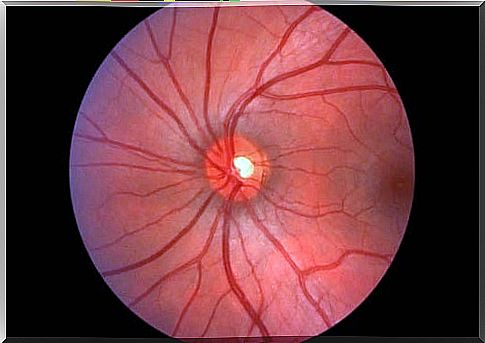Diabetic Eye Disease: Essential Information

High blood sugar is a problem that affects various systems and organs. And he does it in silence. Eye diseases in diabetics are a group of eye problems that can affect people with this condition.
Although experts often discuss the cardiovascular impact of diabetes, there is not much talk about how it can affect vision. Diabetic eye disease can lead to total blindness. In addition, most conditions occur due to poorly controlled diabetes.
Why do diabetic eye diseases occur?
Diabetes is a chronic glucose-related disease. Either the pancreas cannot synthesize enough insulin or the tissues are not able to use it properly.
Insulin is the key substance that allows glucose to enter cells. If it does not do its job, the blood sugar level rises. This damages the tissues. According to experts at the Mayo Clinic, diabetic eye disease occurs because high sugar levels affect the blood vessels behind the eye (retina).
Diabetes is considered a silent disease, which can lead to serious complications in the absence of proper treatment. In fact, as the National Institute of Diabetes and Digestive and Renal Diseases points out, its symptoms are often associated with a change in medication or disease control.
Long-term damage occurs even during prediabetes. Prediabetes is a time when glucose levels are higher than normal. But they are not big enough for medical professionals to diagnose the disease.

Eye diseases in diabetics: essential information
Diabetic retinopathy is a condition that results from damage to the blood vessels that carry oxygenated blood to the retina. The retina is the light-sensitive layer that covers the inside of the eye (in the back of the eye).
Diabetic retinopathy is one of the most common diabetic eye problems. It usually manifests itself in stages. As the American Academy of Ophthalmology explains, the first stage is non-proliferative diabetic retinopathy.
The blood vessels begin to weaken or leak into the retina. At this time, diabetic macular edema occurs, which frequently causes blurred vision. In some cases, it can lead to ischemia of the blood vessels.
As the retinopathy progresses, it reaches the stage of proliferation. This stage consists in the growth of new blood vessels (this process is also called neovascularization or angiogenesis). These vessels are weak, damaged and bleeding.
Bleeding affects vision. It can also form scar tissue, making the inside of the eye more and more opaque. Therefore, light cannot reach the retina properly.
Diabetic macular edema is another common disease in these patients. In fact, as we explained in the previous section, it usually occurs with retinopathy. Accumulation of fluid in the macula is the cause of inflammation.
The macula is the area near the center of the retina. It is responsible for central, high-resolution, color vision. This is why diabetic macular edema can lead to vision loss over time or even blindness.
This is another very common diabetic eye disease. It causes an increase in pressure inside the eye. The eye drainage system is damaged, which causes fluid to build up in front of it.
The disease occurs due to the optic nerve. As explained by the Mexican Diabetes Federation, glaucoma is considered the second leading cause of blindness and the first cause of irreversible blindness worldwide.
The risk of diabetics suffering from this condition is twice as high as that of healthy people. Symptoms appear progressively and vision is gradually lost.
This is a very common condition in healthy people. In fact, it is related to aging. It is a process of wear that leads to opacification of the lens.
This makes it difficult to see clearly. Experts consider it an eye disease in diabetics, because diabetes accelerates the process. In other words, people with diabetes develop cataracts at a younger age than the rest of the population.
When should you consult a specialist?
Diabetic eye disease is a term for a group of asymptomatic conditions until the damage is significant. Therefore, experts believe that it is essential for diabetics to undergo complete eye examinations.
According to the Centers for Disease Control and Prevention (CDC), almost all diabetic eye problems can be prevented. To do this, it is essential to detect your symptoms in time and start to strictly control your blood sugar level.
Medical professionals recommend that all those diagnosed with diabetes undergo certain tests, such as ophthalmoscopy, at least once a year. In fact, it is essential that those who also suffer from hypertension or high cholesterol levels go through these tests.
Having consistently high blood sugar levels increases your risk of diabetic eye disease. Therefore, it is essential for diabetics to control their blood sugar levels throughout the day. In this way, they can adjust their treatment.
You need to remember that if you have been diagnosed with diabetes or prediabetes, medical check-ups are essential. Do not wait to experience symptoms or complications to go to the doctor.

Treatment of diabetic eye diseases
Medications can treat the early stages of diabetic retinopathy. The most used are anti-VEGF agents and corticosteroids. The first drugs reduce the proliferation of blood vessels around the retina. Medical professionals inject them into the eyes. In addition, they also reduce macular edema.
Corticosteroids control the inflammation of the edema. However, some cases do not respond to medication and require surgery. According to the Clinical Hospital of Barcelona, medical professionals must resort to surgery in these cases:
Diabetes is a silent disease
Diabetic eye disease is a group of conditions that result from poor glycemic control, especially in people diagnosed with diabetes many years ago. The most important thing is that most of these eye problems are preventable.
For this reason, it is essential that these patients see a doctor regularly. In addition, following all dietary recommendations and adopting a healthy lifestyle can reduce the incidence of eye diseases.









